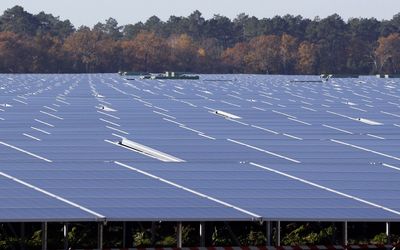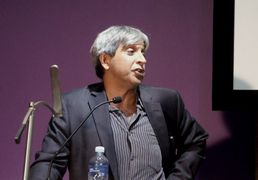IN THE last round of bidding for renewable energy projects, the cost of photovoltaic (PV) solar dropped 68% — the new solar farms will be delivering cheaper electricity than Eskom’s new power stations.
And renewable energy costs will continue to drop while the efficiency of solar panels continues to improve.
Most solar panels in use today have an efficiency rate of 12%-18%. SolarCity, a US company run by three former South Africans, says panels from its new factory in Buffalo, New York, are achieving efficiencies of more than 22% and production costs are so low that no subsidies or incentives are required.
This is just one of a number of solar technologies that are delivering better, cheaper panels.
Manufacturers in the US and elsewhere are making panels that deliver efficiency rates of more than 40%, mainly for use in space. They are expensive, but that could change.
...
ONE of the most exciting prospects comes from Poland. It’s called the perovskite cell and it uses an abundant and cheap material instead of crystalline silicon. The efficiency of the perovskite panel increased from 3.8% in 2009 to 20.1% last year, with a theoretical maximum of 31%. Their low production costs make perovskite solar panels a realistic prospect and they should be on the market by next year.
Quantum dot technology promises even cheaper and better panels. And so on. Not all of these projects will be successful, but some will fly.
Solar panels will continue becoming more efficient and cheaper, some traditional methods of thermal power generation are already obsolete (coal), and others (nuclear) will follow. The only form of thermal power generation that still has a place is the combined cycle gas turbine (60% thermal efficiency), which has low capital costs and the versatility to complement renewables.
Solar is a technology, not a fuel-using industrial process like all thermal power stations. It is a way of harvesting energy (solar radiation) that is already there and converting it into the more usable form of electricity. It does this without using any fuel or labour.
...
ONCE any technology is established, it will be improved, made more efficient and costs will come down as economies of scale are applied and manufacturing methods are improved. This has been happening since the days of the steam engine. Technologies cannot go backwards — the only thing that can happen is that they will be improved or overtaken by a technology that will do the same job more efficiently.
All forms of electricity generation that use fuel to create heat to make steam to drive a turbine to turn a generator produce more waste heat than usable energy.
Aside from the mechanical complications, the real issues are fuel and operating costs. No matter what fuel is used, it has to be gathered, mined or otherwise acquired before being transported, processed and converted into heat.
There are also the costs of dealing with waste products, waste heat and other leftovers that cannot be avoided.
PV solar will become cheaper each year while all thermal power can only get more expensive. Why would any country pour money into a process that will produce increasingly expensive electricity when the cost of the alternative drops every year?
World-renowned futurist and Google’s director of engineering Ray Kurzweil says: "In less than 20 years, solar power will be so inexpensive and widespread that it will meet the entirety of the world’s energy needs at virtually no cost."
He observes that the total amount of solar energy being harvested is growing, not linearly but exponentially. It’s doubling every two years and has been for 20 years. This is a trend that will continue. Kurzweil predicts a total solar takeover — 100% of our energy needs supplied by solar power — in 2027.
Elon Musk of Tesla, SolarCity and SpaceX say solar will supply 50% of energy needs by about 2027. He probably has a better grasp of the enormous manufacturing challenge to produce the vast number of panels that will be required.
...
SOLAR enthusiasts have good support from banks, including South African solar farms. This is what Deutsche Bank predicts: "Solar power will be as cheap as, or cheaper than, electricity from the grid in as much as 80% of global markets by the end of 2017."
SA’s 2013 Integrated Resource Plan (IRP) for electricity got it right when it recommended postponing a decision on nuclear power while adding hydro power, gas power and keeping energy policy flexible because technology was improving so fast. But this report has been ignored while the government clings to the 2010 version that is now hopelessly out of date.
Since 2010, there have been vast gas discoveries off the East African coast and the price of gas has fallen. It is now available in abundant quantities and the price of renewable energy has been falling. Nuclear power has now become a lot more expensive than the estimates in the 2010 IRP.
SA should use natural gas to generate electricity in efficient combined cycle gas turbines and should give priority to energy storage.
The old method is pump storage, like Cape Town’s Steenbras scheme, and SA should examine the prospects for underground pump storage in old, very deep mines, where there are water and civil engineering works.
Concentrated solar also offers a great opportunity to store energy in the form of molten salt at temperatures of about 400°C. This heat can be used to make steam and drive turbines and generators in the conventional way after the sun has set. It will be a lot cheaper than the electricity from open cycle diesel-burning gas turbines.
...
THE third form of storage is lithium ion batteries. Tesla has already produced a viable battery and has been inundated with orders, many of them from US utility companies that want to use them to supply peaking power. Tesla will be opening a branch in SA this year with an eye on the off-grid market.
Musk is building what he calls a Gigafactory in Reno, Nevada, that will produce more lithium ion batteries than the combined output of all the other battery factories in the world.
Its second Gigafactory, double the size of the first, will probably be built in Japan and the third in China. Other companies are making similar plans.
So much has happened since the 2010 IRP was produced and the trends are so clear that it would be irrational to base a vast investment in nuclear power on a hopelessly obsolete plan.
• Myburgh is president of the Cape Chamber of Commerce and Industry

Solar energy. Picture: REUTERS/REGIS DUVIGNAU
IN THE last round of bidding for renewable energy projects, the cost of photovoltaic (PV) solar dropped 68% — the new solar farms will be delivering cheaper electricity than Eskom’s new power stations.
And renewable energy costs will continue to drop while the efficiency of solar panels continues to improve.
Most solar panels in use today have an efficiency rate of 12%-18%. SolarCity, a US company run by three former South Africans, says panels from its new factory in Buffalo, New York, are achieving efficiencies of more than 22% and production costs are so low that no subsidies or incentives are required.
This is just one of a number of solar technologies that are delivering better, cheaper panels.
Manufacturers in the US and elsewhere are making panels that deliver efficiency rates of more than 40%, mainly for use in space. They are expensive, but that could change.
...
ONE of the most exciting prospects comes from Poland. It’s called the perovskite cell and it uses an abundant and cheap material instead of crystalline silicon. The efficiency of the perovskite panel increased from 3.8% in 2009 to 20.1% last year, with a theoretical maximum of 31%. Their low production costs make perovskite solar panels a realistic prospect and they should be on the market by next year.
Quantum dot technology promises even cheaper and better panels. And so on. Not all of these projects will be successful, but some will fly.
Solar panels will continue becoming more efficient and cheaper, some traditional methods of thermal power generation are already obsolete (coal), and others (nuclear) will follow. The only form of thermal power generation that still has a place is the combined cycle gas turbine (60% thermal efficiency), which has low capital costs and the versatility to complement renewables.
Solar is a technology, not a fuel-using industrial process like all thermal power stations. It is a way of harvesting energy (solar radiation) that is already there and converting it into the more usable form of electricity. It does this without using any fuel or labour.
...
ONCE any technology is established, it will be improved, made more efficient and costs will come down as economies of scale are applied and manufacturing methods are improved. This has been happening since the days of the steam engine. Technologies cannot go backwards — the only thing that can happen is that they will be improved or overtaken by a technology that will do the same job more efficiently.
All forms of electricity generation that use fuel to create heat to make steam to drive a turbine to turn a generator produce more waste heat than usable energy.
Aside from the mechanical complications, the real issues are fuel and operating costs. No matter what fuel is used, it has to be gathered, mined or otherwise acquired before being transported, processed and converted into heat.
There are also the costs of dealing with waste products, waste heat and other leftovers that cannot be avoided.
PV solar will become cheaper each year while all thermal power can only get more expensive. Why would any country pour money into a process that will produce increasingly expensive electricity when the cost of the alternative drops every year?
World-renowned futurist and Google’s director of engineering Ray Kurzweil says: "In less than 20 years, solar power will be so inexpensive and widespread that it will meet the entirety of the world’s energy needs at virtually no cost."
He observes that the total amount of solar energy being harvested is growing, not linearly but exponentially. It’s doubling every two years and has been for 20 years. This is a trend that will continue. Kurzweil predicts a total solar takeover — 100% of our energy needs supplied by solar power — in 2027.
Elon Musk of Tesla, SolarCity and SpaceX say solar will supply 50% of energy needs by about 2027. He probably has a better grasp of the enormous manufacturing challenge to produce the vast number of panels that will be required.
...
SOLAR enthusiasts have good support from banks, including South African solar farms. This is what Deutsche Bank predicts: "Solar power will be as cheap as, or cheaper than, electricity from the grid in as much as 80% of global markets by the end of 2017."
SA’s 2013 Integrated Resource Plan (IRP) for electricity got it right when it recommended postponing a decision on nuclear power while adding hydro power, gas power and keeping energy policy flexible because technology was improving so fast. But this report has been ignored while the government clings to the 2010 version that is now hopelessly out of date.
Since 2010, there have been vast gas discoveries off the East African coast and the price of gas has fallen. It is now available in abundant quantities and the price of renewable energy has been falling. Nuclear power has now become a lot more expensive than the estimates in the 2010 IRP.
SA should use natural gas to generate electricity in efficient combined cycle gas turbines and should give priority to energy storage.
The old method is pump storage, like Cape Town’s Steenbras scheme, and SA should examine the prospects for underground pump storage in old, very deep mines, where there are water and civil engineering works.
Concentrated solar also offers a great opportunity to store energy in the form of molten salt at temperatures of about 400°C. This heat can be used to make steam and drive turbines and generators in the conventional way after the sun has set. It will be a lot cheaper than the electricity from open cycle diesel-burning gas turbines.
...
THE third form of storage is lithium ion batteries. Tesla has already produced a viable battery and has been inundated with orders, many of them from US utility companies that want to use them to supply peaking power. Tesla will be opening a branch in SA this year with an eye on the off-grid market.
Musk is building what he calls a Gigafactory in Reno, Nevada, that will produce more lithium ion batteries than the combined output of all the other battery factories in the world.
Its second Gigafactory, double the size of the first, will probably be built in Japan and the third in China. Other companies are making similar plans.
So much has happened since the 2010 IRP was produced and the trends are so clear that it would be irrational to base a vast investment in nuclear power on a hopelessly obsolete plan.
• Myburgh is president of the Cape Chamber of Commerce and Industry


























Change: 0.79%
Change: 0.68%
Change: 1.29%
Change: 0.34%
Change: 1.65%
Data supplied by Profile Data
Change: 1.38%
Change: -0.34%
Change: 0.79%
Change: 0.00%
Change: -0.19%
Data supplied by Profile Data
Change: 3.71%
Change: 3.12%
Change: 3.05%
Change: 2.91%
Change: 2.30%
Data supplied by Profile Data
Change: -0.05%
Change: -1.30%
Change: -0.14%
Change: 0.21%
Change: 0.14%
Data supplied by Profile Data